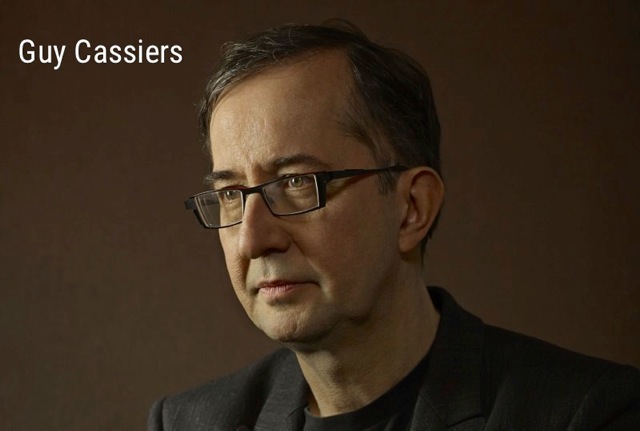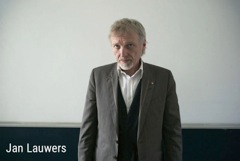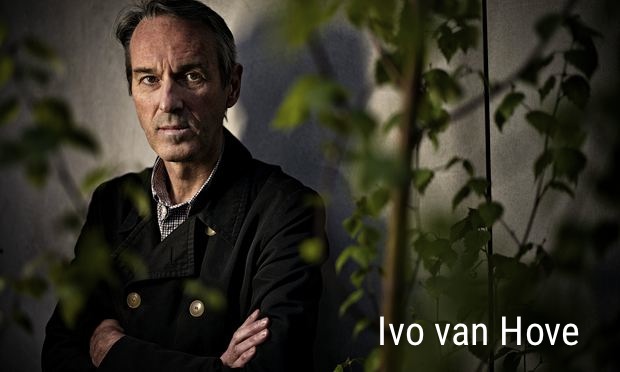Directors

Photo: Frieke Janssens
Guy Cassiers (Belgium, Antwerp, 1960) is the artistic director of Het Toneelhuis, Flander’s largest theatre company. He started his career completely in the margin with small-scale solo work based on his fascination for language. In his first performance Kaspar (after Peter Handke’s Kaspar Hauser), he put a figure on stage that yet has to discover language and in that learning process also finds out how language is also a disciplining tool. Constant in his work is his choice for pre-eminently literary work as Proust’s A la recherche du temps perdu (Ro Theater, 2002-2004) that he put on stage as a four-part cycle. From his obsession with the sound and musicality of language one can understand why he is also very much involved in opera and music theatre. One of the many highlights in Cassiers’ work is the musical theatre production The Woman Who Walked into Doors (Muziek Lod / Ro Theater, 2001).
Besides that love for literature Cassiers’ hallmark is also his obsession with images. Since his discovery of the possibilities of image projection, quite early in his career, he has embraced the digitization of the image and thus opened up a whole new language for the theatre medium. He thinks his stories in images and unfolds the plot from a visual dramaturgy. The use of technology is mainly an aesthetic agent that provides subtle ambiance and an effect of sensory immersion.
Typical for Cassiers’ creative processes is his collaborative effort to bring ideas of the costume designer, set designer, light designer, image designer, dramaturg and writers together. Cassiers is responsible for the main ideas and the broad conceptional framework of a new performance but depends heavily on his closest collaborators to develop these ideas and translate them on the stage. His notebooks consist of written ideas and comments, partly whipped out in every new phase of the rehearsal process to make place for new notes.
When Romeo Castellucci, Claudia Castellucci and Chiara Guidi founded the Socìetas Raffaello Sanzio in the 1980s, their goal was from the outset to create a “Theatre of Images.” Skeptical about our linguisticly driven art and society, they desired a language understandable for everyone, all over the world. By investigating the boundaries of theatrical representation, the in Cesena based theatre company searches for the “original, mythical image,” recognisable for the entire audience. The result are visually overwhelming performances, with often intriguing soundscapes, ingenious theatrical machines and a radical physicality of the performers - not seldom displaying extreme forms of illness, age, size, and so on. Disposed of a lineair narrative structure, the public is faced with complex, fragmentary performances that are multilayered and open to multiple interpretations. In their ambition to equally combine different theatrical elements (as sound, body, costumes, decor, etc.) as well as integrally unite different artforms (as the visual arts (painting, sculpture), music, literature, architecture, etc.), the SRS form a perfect example of Hans-Thies Lehmann’s “postdramatic theatre” in which the drama text loses its all-decisive and structuring position as the most important theatrical sign.
Despite his desire to create an image-based language, Castellucci’s notes are surprisingly linguistic. Although he seems to be one of the most visual directors within our eight selected postdramatic theatre makers, his notes are (regarding form) one of the most classic among our corpus, namely consisting out of written notes in paper notebooks. Using it as initial platform for his endless emerging of ideas, Castellucci always carries with him a small notebook. With red ink, symbols and lines, he “tracks constellations” within the amalgam of ideas in this “book of chaos.” Arranging the selected ideas in a strict structure, the work is mostly finished before they even go in rehearsal. The radical performances of this Italian avant-garde theatre company has gained audiences as well as protests all over the world.

Photo: Stephen Mattues
Jan Fabre (Belgium, Antwerp, 1958) started his career in fine arts and theatre from 1976. His eight hour performance It Is Theatre as was to be Expected and Foreseen (1982) made a strong appearance on several European performance festivals and launched his international reputation. Since the eighties, his pioneering work crossed the borders of theatre, dance and performance art. He developed a theatrical language that is, in the first place, built on physicality. Much inspired by the use of real time/real action in performance art he creates theatre out of real physicality on stage.
Fabre’s notebooks consist mainly of drawings. His drawings are made at night, after or before the rehearsals. His drawings are used as an inspirational source for the improvisation sessions with his performers or they are made as a result of these impro’s. He uses many different techniques of drawing, adapted to the specific performance he is elaborating. Typical for Fabre’s drawings is the interplay of drawing and language: next to the drawing you’ll find a task, a description of atmosphere, a title or the like. And each drawing has a date and a signature as is the case in fine arts. It’s clear that the borderline between his theatre work and fine arts is quite thin.

Photo: Claudine Doury
When Jan Lauwers (Belgium, Antwerp, 1957) travels, he always carries with him a small notebook, in which he jots down impressions, thoughts, words, sentences, larger chunks of text, drawings, sketches, and so forth. “The best ideas come up when I am in transitory zones,” he says, “at moments of transport, literally.” There is no doubt that Jan Lauwers is often en route: together with his troupe of performers, he is a frequent guest on various theatre stages, in Belgium, Europe, and beyond. The ensemble is known as Needcompany, which Lauwers founded together with Grace Ellen Barkey in 1986. From the very beginning, the name made it obviously clear that both Lauwers and Barkey “need company” and, even after more than 25 years, it still serves as a sign for the intensely collaborative nature that characterizes the creative processes of the group.
Lauwers prefers to call himself a theatre maker instead of a director, who works with performers rather than with actors. During rehearsals, his performers are challenged to experiment freely with the assignments, objects, or texts that Lauwers brings into the studio. This approach results in a great conviviality among the group members, which is clearly reflected on stage, just as many of Lauwers’ pieces strike by their exuberant atmosphere and inventive visual imagery. Indeed, since Lauwers not only works in the theatre but also as a visual artist, both disciplines are never entirely separated in his oeuvre. Drawing is in fact one of the primary means for him to create theatre. His personal archive is replete with sketches, aquarelles, and other kinds of blueprints that visualize the exploratory imagination of the artist.
From the 1990s onwards, however, a remarkable shift occurred in Lauwers’ career as literary text began to play an increasingly important role in his theatre. Besides adaptations of novels or classic repertoire, Lauwers also proved to be a prolific author himself, starting with The Snakesong Trilogy (1994-1996) and probably culminating in his much acclaimed Isabella’s Room (2004). Yet narrative has never entirely replaced the dominance of the image in Lauwers’ work and also his notebooks testify to this. These documents therefore provide intriguing specimen in which word and image exist in a continuous state of interaction.
Fed up with classical subsidised theatre, Luk Perceval (°1957) wanted to change the theatrical medium from within. With Guy Joosten he established the Blauwe Maandag Compagnie (1984–1998), in which they strived for a more physical acting and tried to bring theatre closer to the spectator’s and actor’s own environment. This exciting theatre company became known for what would become one of the main features of the theatre artists of the ‘Flemish Wave,’ namely the appropriation of classical texts through sampling and montage. Perceval, freed from sanctity, boldly edits and breaks open classical dramatic texts (as for example Shakespeare’s tragedies), filling them with improvisations and retaining only the most necessary parts. This bold (re-)writing process of cut and paste was initially done by hand - the handwritten or typed out prints were cut up and rearranged with glue – before Perceval replaced this tiresome process with computers and text processing software. From the outset an early adopter of digital media, he has used different digital developments to exchange and circulate text versions as well as other ideas concerning the performance among his collaborators. Today, Perceval makes active use of the web-based file hosting service Dropbox, to share consecutive new versions during the preparation and rehearsal of a production. In addition, he shares inspirational images, work in progress and reflections through a blog and a website (see lukpercevaljournal.tumblr.com and www.lukperceval.info).
However, his most interesting form of note taking consists of the use of film and video. From the beginning of his career, Perceval would make video registrations of the rehearsals of a play, edit the footage at night and show this the following day during the next rehearsal. This endless process of filming and editing serves several functions, of which the transposition of cinematic qualities to the theatrical medium, such as the acting style and light design, is one of the most intriguing ones. Resulting in even films of the rehearsal process, Perceval’s theatre is steeped with cinema - paradoxically not resulting in videotaped images as part of the mise en scène of the final performance, as is the case with Guy Cassiers en Ivo Van Hove.
During his period as the artistic director of the Antwerp municipal theatre Het Toneelhuis (1998–2005), he himself managed the camera as a literal “camera-stylo.” In 2005 he left Belgium to become house director at the Shaubühne am Lehniner Platz Berlin, and since 2009 he is the “leading director” of the Thalia Theater in Hamburg. In Germany his director’s assistants handle the camera. “I direct with empty hands now,” Perceval states.

Photo: Sarah Lee/The Guardian
In the hands of Ivo van Hove (Belgium, Heist-op-den-berg, 1958), text becomes a malleable material that he, seemingly without any effort, bends to his own will. Whether it concerns Greek tragedies, Shakespeare’s dramas, French classicist repertoire, or even classic film scripts, there is hardly any genre that one could think of or van Hove has staged it. What generally characterizes the theatre of van Hove is that he redresses literary texts in a contemporary aesthetics, which not only brings them closer to our own cultural sensibilities, but also makes them pertinently relevant to current societal questions, no matter how distant in time the original story is set. Pieces such as van Hove’s re-interpretation of Henrik Ibsen’s Hedda Gabler (2006) or his theatrical staging of Ingmar Bergman’s movie Scenes from a Marriage (2005), for instance, exemplify the craftsmanship of a director who, by excavating unexpected dramatic and dramaturgical layers, excels in continuously re-inventing the repertoire of the theatre. Since 2001, van Hove is artistic director of Toneelgroep Amsterdam, one of the Netherlands’ leading theatre companies, which allows him to work with some of the most skilled and charismatic actors of the Dutch-Belgian artistic scene. Their emotional investment in van Hove’s plays is crucial to the compelling power and intensity of the narratives he puts on stage. Likewise, the longstanding collaboration between van Hove and set designer Jan Versweyveld is known as an essential aspect of the theatrical language that van Hove has been developing throughout his career. Depending on the nature of the story, the scenographies of Versweyveld range from the extensive use of multimedial screenings to extremely sober settings, but above all they amplify the existential and brooding atmosphere that characterizes van Hove’s productions. Besides theatre, Ivo van Hove has also directed a range of operas, including the entire “Ring”-cycle by Wagner (2006-08). Over the years, van Hove established a firm reputation as one of the greatest directors in contemporary theatre, being honoured with various awards and showing his work all over the world.
